Surface-Enhanced Raman Spectroscopy: A New Approach to Rapid Identification of Intact Viruses
Surface-enhanced Raman spectroscopy (SERS) has experienced an explosive resurgence in interest lately. Development of reproducible, spatially uniform SERS-active substrates has made this technique an attractive approach for identification of Raman-active compounds and biological materials including toxins, intact viruses, and intact bacterial cells–spores...
Biological warfare can be classified broadly in one of three ways: the deliberate poisoning of food or water with infectious material; the use of microorganisms, toxins (that is, biologically derived poisons), or animals (living or dead) in weapon systems; or implementation of biologically inoculated materials (for example, fabrics or tools) (1). Throughout recorded history, biological warfare has been manifested in each of these routes. For example, as early as the sixth century B.C., Assyrian warriors poisoned an adversary's water supply with rye ergot (Claviceps purpurea), a grain fungus that causes delusion, convulsion, and gangrene in humans and livestock (2). Since this initial demonstration of biology as a weapon, there have been numerous examples of intermittent application of virulent organisms or etiological by-products to reduce the military strength of a foe.
More recently, an increase in the number and severity of worldwide bioterrorist acts combined with information suggesting that several different biological agents of biosecurity concern have been weaponized by various groups around the globe highlights the fact that biological attacks are a plausible if not imminent reality (3,4). Notably, etiological agents such as bacterial endospores and viruses have become of particular interest recently. For example, the rapid and accurate discrimination of smallpox (for example,variola major), a Poxviridae virion, from other exanthem-causing viruses has become a central concern in the contradiction of possible bioterrorist and agro-terrorist attacks.
The current unavailability of reliable identification protocols underscores the urgency to develop methods for rapid identification of potential biological threat agents including variola major as early as possible (in-the-field). While latent threats of biological threat agents have been recognized for several decades, only recently has the urgency to address these threats through development of potentially field-deployable methods been acted upon (5). One sensing methodology that holds significant promise to fulfill this technological void is surface-enhanced Raman spectroscopy (SERS) (6).
Of late, SERS has experienced a resurgence in interest due to the high sensitivities attainable by most surface-enhanced spectroscopic techniques. A plausible explanation for a significant portion of the spectral amplification achieved through SERS can be attributed to an increase in the electromagnetic field strength encountered by the analyte. Briefly, this intensified electromagnetic field is generated when a metal surface (typically, Au, Ag, Pt, Pd, or Cu) is irradiated with the requisite wavelength of light, and metal conduction band electrons are excited to collective oscillation through a surface plasmon resonance. Additionally, with certain metal–analyte systems, enhancements of 4–14 orders of magnitude are achieved readily. Since early reports, its acceptance has not been as widespread as expected. This limited acceptance has in large part been due to the lack of fabrication reproducibility in most SERS substrate architectures. Relatively recent advances in SERS-active substrate fabrication have addressed this reproducibility issue through development of commercial-off-the-shelf (COTS), durable, biocompatible, and long shelf-life substrates (7).
Experimental
Instrumentation
Raman Microscope: All SERS measurements were acquired using a Renishaw inVia Reflex Raman microscope (Hoffman Estates, Illinois) equipped with a near-infrared (NIR) diode laser excitation source. Light from the high-power diode (λ = 785 nm) was focused onto the sample at the microscope stage through a 20× objective. The diode laser beam was circularized, by inserting a pinhole into the optical beam path with reduction of the maximum available laser power to ~20 mW. Before all measurements, the instrument was wavelength calibrated using an internal Si standard. Each SERS spectrum was collected from 350 cm–1 to 1400 cm–1 in the instrument's Extended SynchroScan mode (10.00-s exposure time) with a spectral resolution better than 2 cm–1 and is the result of a single accumulation unless otherwise stated. All spectra were saved in ASCII format for subsequent analysis using other software packages.
Materials
SERS-Active Substrates: Au-coated Klarite SERS-active substrates were purchased from D3 Technologies LTD (Southampton, Hampshire, United Kingdom). To facilitate easy handling and positioning, the 6 mm × 10 mm chip (consisting of a 4 mm × 4 mm patterned region and an unpatterned Au reference area) is adhered to a standard microscope slide (25 mm × 75 mm) at the foundry. The substrates were used as received without further modification.
Poxviridae virions: Bovine papular stomatitis virus (ATCC VR-801) and pseudocowpox virus (ATCC VR-634) intracellular mature virions (IMV) were purchased from American Type Culture Collection (Manassas, Virginia). The virions were prepared by propagation on bovine embryonic kidney cells for 4 days and 3 days, respectively. Subsequent to growth, mature virions of each species were purified by the CsCl gradient centrifugation method. Viral titers of 1.0 × 102, 1.0 × 103, 1.0 × 104, 1.0 × 105, and 1.0 × 106 virions/mL for each virus were prepared by serial dilution of each viral stock suspension in de-ionized water. Before SERS spectra acquisition, 1.00 μL of each viral suspension was deposited onto the substrate and the sample was dried at room temperature, leaving intact viral particles on the substrate surface.
Software
Chemometric Software: The Unscrambler (version 7.6) chemometric development software was purchased from Applied Chemometrics (Sharon, Massachusetts) and was used to develop partial least squares regression algorithms for classification of unknown samples. Training spectra and data for classification were imported into this software as ASCII format.
Results and Discussion
Through maturation of micromachining techniques and high-resolution analysis tools, it is currently possible to routinely fabricate devices with precisely placed building blocks or components (8,9). These efficient fabrication techniques and analysis tools have been leveraged to develop reproducibly manufacturable SERS-active substrates. Conceivably, variances associated with many proposed SERS-based detection approaches can be mitigated greatly by employing spatially uniform and reproducible SERS-active substrates. To address this technological challenge, recently, lithographically patterned surfaces promoted as SERS-active substrates have been made available in the marketplace. Illustrated in Figure 1 is a schematic representation of these SERS-active chips fabricated by anisotropically wet etching (1 0 0) oriented Si wafers followed by vapor deposition of approximately a 100-nm thick layer of Au. In short, these commercialized SERS chips contain a 4 mm × 4 mm patterned region surrounded by an uncorrugated reference region. Scanning electron microscopy (SEM) analysis of these patterned regions shows that the patterned surface is composed of C4V-symmetric depressions (spaced at a period of 2 μm) and spatially uniform over areas occupying at least 0.1 mm2 .
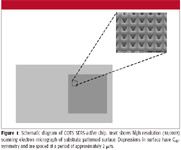
Figure 1
In addition to SEM, we have employed a well-established methodology proposed by the Rowlen group (10) to quantitatively assess the performance of these plasmonic surfaces for SERS applications. Specifically, trans-1,2-bis(4-pyridyl)ethylene (BPE) was used as a Raman-active target molecule to assess the substrate spatial uniformity and substrate-to-substrate reproducibility. Briefly, dilute ethanolic solutions of BPE were spin-coated onto the substrate surface (at approximately 1000 rpm) using a home-built spin-coater. As part of this analysis, SERS spectra were acquired at random sites across the substrate surface; this experiment was repeated over several COTS SERS-active substrates. Results of this analysis are depicted in Figure 2. As illustrated in Figure 2a, the mean SERS spectra of various densities of BPE are similar in shape and linear (with respect to analyte density) over more than one order of magnitude. The depicted results confirm that these surfaces are sensitive and spatially uniform, and have high substrate-to-substrate reproducibility.
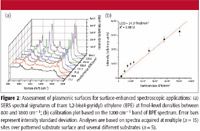
Figure 2
The high sensitivity, spatial uniformity, and substrate-to-substrate reproducibility of these COTS SERS-active substrates prompted us to further investigate utilizing these surfaces as a basis for the rapid detection/discrimination of potentially high-consequence biological threat agents such as smallpox (for example, variola major). In addition to variola major's environmental robustness, to date it has been difficult to develop reliable techniques for its unambiguous identification in field-deployable applications. Further, clinical presentation of smallpox poses a challenge in medical diagnosis because it is nearly indistinguishable from several other external exanthems (11,12). For example, most physicians lack the experience to distinguish smallpox, human monkeypox, and chickenpox quickly. Rapid and accurate differential diagnosis of such conditions is especially critical because confirmation of a single case of smallpox represents a national security concern. Conversely, diagnosis of human monkeypox in disease naïve regions of the world (absent of additional indicators of biowarfare activity) or diagnosis of isolated cases of chickenpox do not represent a cause for alarm (13,14).
Plotted in Figure 3 are representative, intensity-normalized SERS spectra of pseudocowpox virus (PCPV) and bovine papular stomatitis virus (BPSV) over the Raman shift range from 350 cm–1 to 1400 cm–1 . Study of these virions is especially interesting because they are genetically similar to variola major (smallpox). In general, these viral spectra are dominated by features centered near 455-, 853-, 1003-, and 1168 cm–1 . Comparison of BPSV and PCPV shows strong similarity between their spectral signatures. However, the BPSV spectrum contains spectral features at 539-, 853-, and 1168 cm–1 that are absent in the PCPV spectrum. Further, these data imply that it is possible to distinguish BPSV and PCPV based upon their molecular composition and hence, SERS spectral signatures.
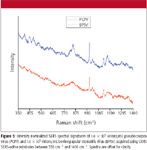
Figure 3
Unique spectral features apparent in each spectrum make it possible to distinguish between these viruses by univariate (that is, dependent upon a single Raman shift frequency) calibration approaches. However, using most univariate calibration approaches, it is not possible to identify multiple bioanalytes simultaneously (that is, virions). An alternative approach to identification is to leverage the strengths of multivariate (that is, full spectrum) calibration; namely, ease of simultaneous identification of multiple analytes; highly correlated adjacent Raman shift frequencies improve classification precision as well as fault (that is, unknown interferents) detection; and developed classification algorithms can be automated to aid in identification of unknown viral samples by nontechnical personnel (15–18).
One such multivariate calibration approach is the partial least squares 2 (PLS2) method. We have used this well-established chemometric approach to develop a personal computer-borne model that can be used for the rapid and accurate identification of virus samples. In concept, this model simultaneously utilizes two cooperative algorithms that are devoted to identification of samples that contain either BPSV or PCPV. Tandem application of these statistical algorithms facilitates the rapid classification (that is, identification) of unknown SERS spectral signatures. Briefly, these algorithms were trained using PCPV and BPSV samples over the viral titer range from 1 × 102 to 1 × 106 virions/mL. Internal cross-validation analysis of this predictive model illustrates that it performs optimally using only eight principal components (PCs).
To further validate performance of this model, 50 (25 PCPV and 25 BPSV) unknown viral SERS spectral signatures were classified. As listed in Table I, viral test samples used to validate performance of the developed model contain either BPSV or PCPV with viral titers ranging from 1 × 102 to 1 × 106 virions/mL.
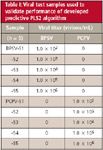
Table I: Viral test samples used to validate performance of developed predictive PLS2 algorithm
Figures 4a and 4b show results of the simultaneous classification of the viral test samples based on the developed model. Shown in these figures are the viral test sample designation (that is, BPSV-S1 or PCPV-S1) and the probability of classification calculated by the PLS2 model. Integral to classification, we establish an arbitrary threshold at the 50% probability of classification level. In principle, probability of classification values above this threshold are indicative of viral species identification, while values below this threshold are insufficient for identification. Applying this filter, the predictive model correctly classifies all unknown viral samples with no false positives or false negatives. These data demonstrate that multivariate models trained using intrinsic viral SERS spectral signatures can be utilized to aid in efficient identification of intact Poxviridae virions using these lithographically patterned SERS-active substrates.
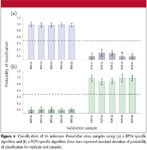
Figure 4
Conclusions
SEM and a well-established, quantitative SERS substrate assessment methodology have been used to characterize COTS SERS-active substrate architecture. Results of these analyses show that these substrates are sensitive, spatially uniform, and reproducible from substrate to substrate. High spatial uniformity and substrate-to-substrate reproducibility coupled with availability from a commercial source makes these substrates a prime candidate to be used as the foundation in development of novel surface-enhanced spectroscopic approaches.
We have used these plasmonic surfaces to develop a novel SERS-based methodology for the rapid identification of intact Poxviridae virions. Intrinsic SERS spectral signatures of BPSV and PCPV, taxonomically close relatives of smallpox (for example, variola major), acquired with these substrates have been used as a basis set to develop a computer-borne PLS2 predictive model. This model is designed to quickly identify unknown viral samples that contain either BPSV or PCPV. To validate this model, we have categorized 50 unknown viral samples. Results of these validations illustrate that this model correctly classifies all of the viral samples considered with no false positives or false negatives. It is noteworthy that a primary caveat for optimal performance of this model is strong correlation between the SERS spectral signatures in the training basis set and the SERS viral spectral signatures considered for classification. Accordingly, high substrate spatial uniformity and substrate-to-substrate reproducibility are essential.
Troy A. Alexander is with the U.S. Army Research Laboratory, Sensors and Electron Devices Directorate, Optics & Photonics Integration Branch, Radiometric Sensor Development and Applications Team, Adelphi, Maryland.
References
(1) "Biological warfare," Wikipedia, The Free Encyclopedia. 8 Dec 2005; en.wikipedia.org/w/index.php?title=Biological_warfare&oldid=30645865.
(2) M.B. Phillips, Northeast Florida Medicine 56, 32–35 (2005).
(3) J.B. Tucker, Emerg. Inf. Dis. 5(4), 498–504 (1999).
(4) K. Alibek and S. Handelman, Biohazard: The Chilling True Story of the Largest Covert Biological Weapons Program in the World — Told from Inside by the Man Who Ran It (Random House, New York,1999).
(5) The Royal Society. "Measures for controlling the threat from biological weapons". Accessed November 2006. Available from URL: www.royalsoc.ac.uk/displaypagedoc.asp?id=11409.
(6) J.R. Ferraro and K. Nakamoto, Introductory Raman Spectroscopy (Academic Press, San Diego and London, 1994), Chapter 3.
(7) N.M.B. Perney et al., Opt. Express 14(2), 847–857 (2006).
(8) A.R. Neurath et al., Appl. Surf. Sci. 164(1–4), 111–117 (2000).
(9) M. Kahl et al., Sens. Actuators, B 51(1–3), 285–291 (1998).
(10) K.L. Norrod, L.M. Sudnik, D. Rousell, and K.L. Rowlen, Appl. Spectrosc. 51(7), 994–1001 (1997).
(11) D.A. Henderson, et al., JAMA 281(22), 2127–2137 (1999).
(12) J.G. Breman and D.A. Henderson, N. Engl. J. Med. 346(17), 1300–1308 (2002).
(13) S.M. Bernard and S.A. Anderson, Emerg. Inf. Dis. 12(12), 1827–1833 (2006).
(14) K.D. Reed et al., N. Engl. J. Med. 350(4), 342–350 (2004).
(15) H. Martens and T. Naes, Multivariate Calibration (John Wiley and Sons, New York, 1989).
(16) R. Kramer, Chemometric Techniques for Quantitative Analysis (Marcel Dekker, Inc., New York, 1998).
(17) T.A. Alexander and C.D. Tran, Anal. Chem. 73, 1062–1067 (2001).
(18) K.R. Beebe, R.J. Pell, and M.B. Seasholtz, Chemometrics: A Practical Guide (John Wiley and Sons, New York, 1998).
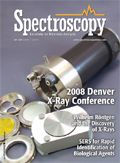
AI-Powered SERS Spectroscopy Breakthrough Boosts Safety of Medicinal Food Products
April 16th 2025A new deep learning-enhanced spectroscopic platform—SERSome—developed by researchers in China and Finland, identifies medicinal and edible homologs (MEHs) with 98% accuracy. This innovation could revolutionize safety and quality control in the growing MEH market.
New Raman Spectroscopy Method Enhances Real-Time Monitoring Across Fermentation Processes
April 15th 2025Researchers at Delft University of Technology have developed a novel method using single compound spectra to enhance the transferability and accuracy of Raman spectroscopy models for real-time fermentation monitoring.
Nanometer-Scale Studies Using Tip Enhanced Raman Spectroscopy
February 8th 2013Volker Deckert, the winner of the 2013 Charles Mann Award, is advancing the use of tip enhanced Raman spectroscopy (TERS) to push the lateral resolution of vibrational spectroscopy well below the Abbe limit, to achieve single-molecule sensitivity. Because the tip can be moved with sub-nanometer precision, structural information with unmatched spatial resolution can be achieved without the need of specific labels.